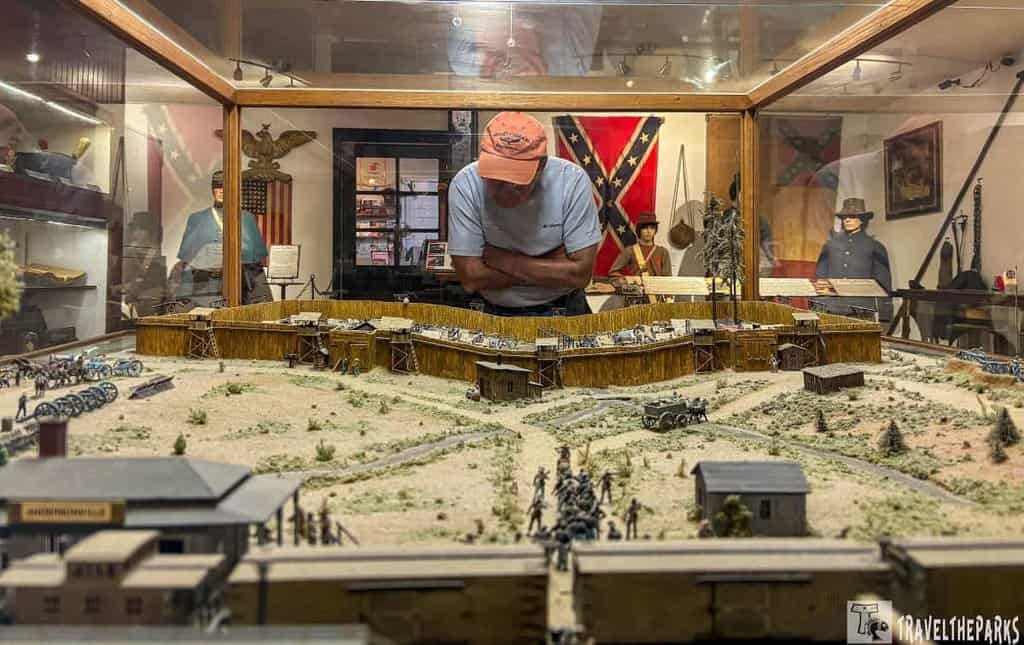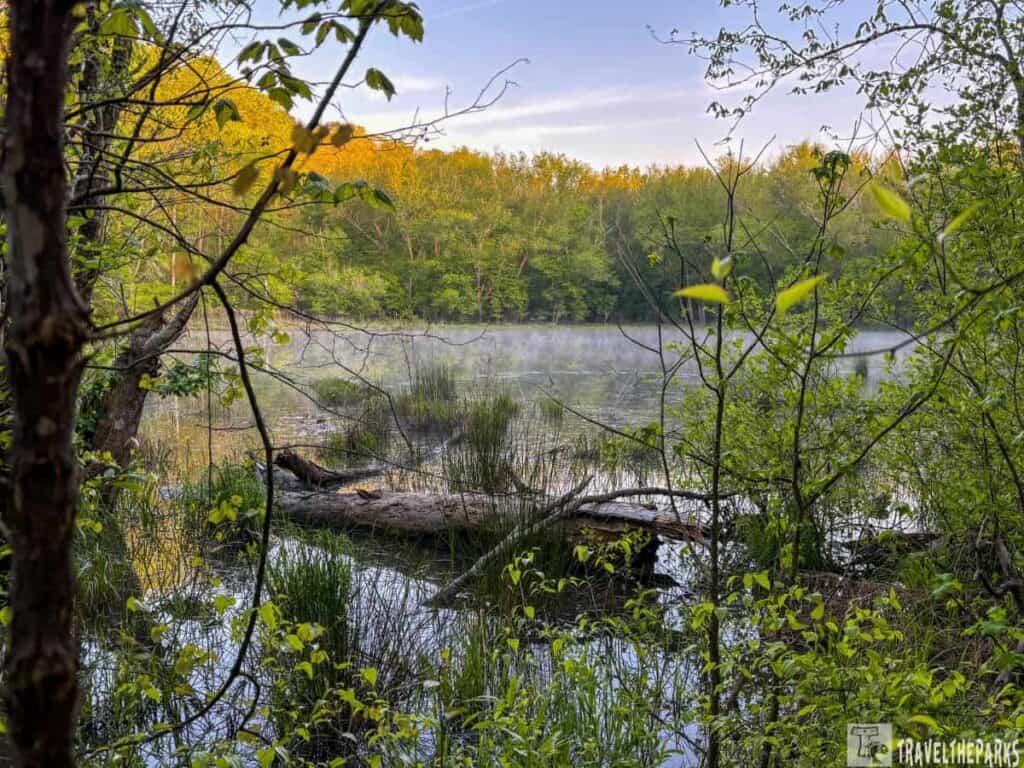Visiting Andersonville National Historic Site can be a powerful experience. Understanding how to make the most of your visit can really enhance your time there. If you love history as much as we do or want to learn about an important part of American heritage, this place gives you an amazing chance to travel back in time. It’s a place where history speaks softly through quiet fields and well-kept surroundings. Andersonville gives visitors a meaningful experience by highlighting the powerful stories of bravery and sacrifice about the Civil War’s most famous prison. I underestimated how much of an impact this national historic site would make on us. Our complete guide will help you make the most of your visit and make sure you understand the history of this important place.
This post may contain affiliate links, meaning if you purchase something through one of these links, we may earn a small commission at no extra cost to you! Read the full disclosure policy here.

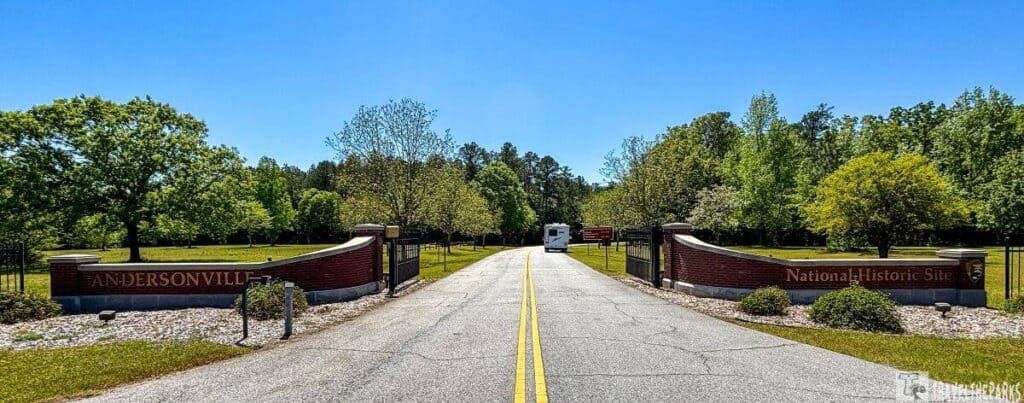
Table of Contents
Getting to Andersonville National Historic Site
Andersonville National Historic Site is in southwest Georgia, about 10 miles northeast of Americus and 60 miles southwest of Macon.
- By Car:
- From Atlanta: Approx. 2.5 hours (140 miles) via I-75 South to GA-49 South.
- From Macon: About 1.5 hours via US-280 West or GA-49 South.
- From Albany, GA: About 1 hour via US-19 North to GA-27 East.
- By Air
- The nearest major airport is Hartsfield-Jackson Atlanta International Airport (ATL).
- From ATL, rent a car for the drive to Andersonville—there is no public transit directly to the site.
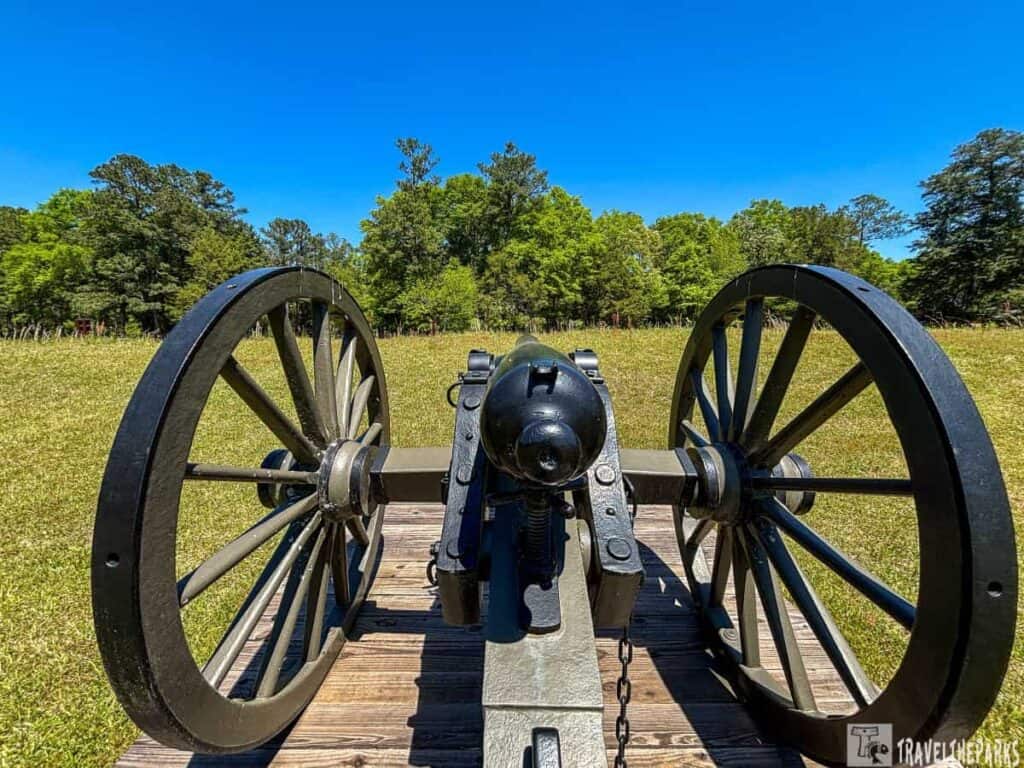
Essential Tips for Visiting Andersonville National Historic Site
- Location & Hours: Address: 496 Cemetery Rd, Andersonville, GA 31711 (2 hours south of Atlanta). The site is open year-round, but hours may vary depending on the season, so it’s worth checking ahead. There’s plenty of parking, and the park is accessible to all, including those with mobility impairments. Open daily, 8 AM–5 PM (check NPS website for updates).
- Entrance, Admission & Fees: Free entry to the park, museum, and cemetery. Donations appreciated at the National Prisoner of War Museum. There is a nominal entrance fee to visit the park, but it’s free if you have a National Park Annual Pass. If you’re planning on exploring the entire site, including the museum and cemetery, expect to spend at least 2–3 hours here.
- Download the National Park Service app for Andersonville, or pick up a free map at the visitor center.
- Best Time to Visit: spring (March to May) and fall (September to November) when temperatures are mild, and the grounds are most comfortable to explore on foot.
- Facilities: restrooms and water at the visitor’s center; no on-site food—pack snacks.
- RV Camping: If you’re an RV traveler, you’ll love the camping facilities at the park. The Andersonville RV Campground offers full hookups, making it easy to enjoy the park while camping in comfort. Don’t forget to reserve your spot in advance, especially during peak seasons!
- What to Pack: Don’t forget your comfortable walking shoes—there’s a lot of ground to cover! Also, bring water, sunscreen, and a hat, as you’ll be outdoors for most of the day. If you’re camping, remember to pack camping essentials, including firewood, a cooler, and your favorite outdoor gear.
- Combine this park with a visit to Jimmy Carter National Historic Park just a few miles down the road.

1. Visitor Center and National Prisoner of War Museum
Start here. The visitor center is the gateway to the Andersonville National Historic Site and is where our self-guided tour began. Inside, we found the National Prisoner of War Museum.
- Key Exhibits:
- Timeline of POW History: This exhibit takes you through the history of POWs in the U.S. military, beginning with the Revolutionary War and continuing through modern-day conflicts.
- Civil War Focus: A large section dedicated to the history of Andersonville Prison (Camp Sumter) and the 13,000 Union soldiers who died here from disease, malnutrition, and neglect.
- Survivor Stories: Personal letters, diaries, and first-hand accounts from former POWs, as well as photographs of survivors who lived through Andersonville.
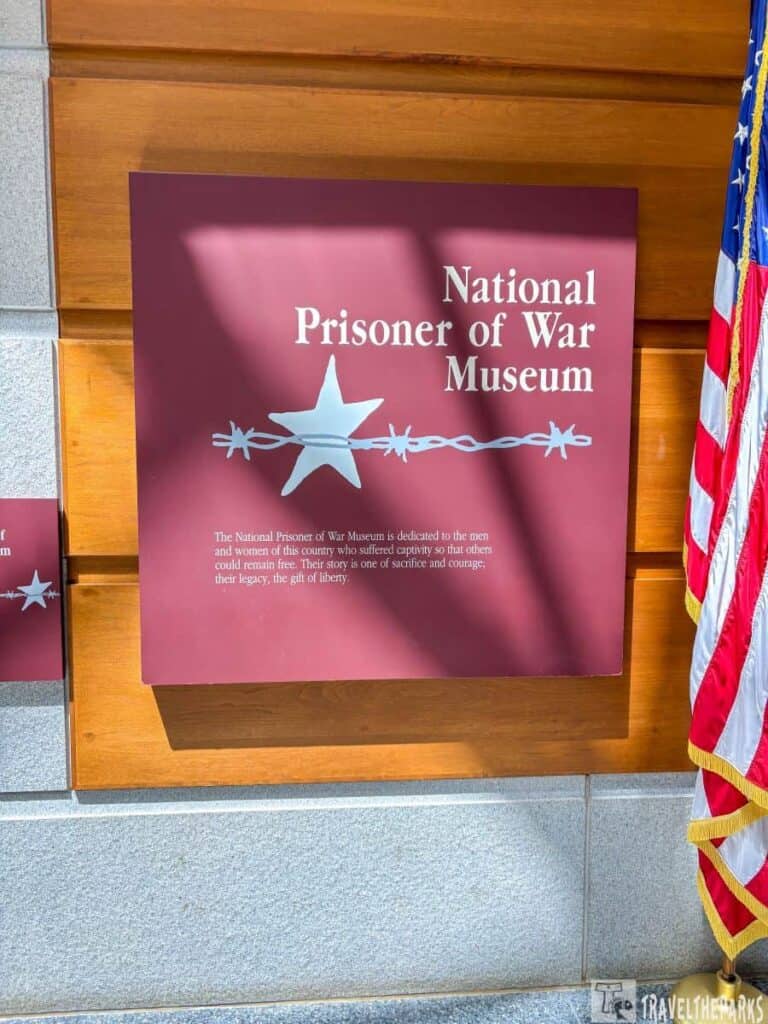
A Legacy of Suffering: The Enduring Stories of POWs Across History
Exploring Andersonville Prisoner of War Museum, we quickly discovered its scope stretches far beyond the Civil War. Thoughtfully curated exhibits illuminated the harrowing realities faced by POWs throughout history, from Andersonville’s notorious camp to others across different conflicts. Powerful displays revealed prisoners’ resilience amid unimaginable suffering: starvation, overcrowding and despair. For me, the most haunting were the stories of those sold into slavery post-capture. Slavers stripped them of freedom again, forcing them into brutal labor. For us, their tragedies lay bare war’s dehumanizing toll. It’s a raw reminder of humanity’s capacity for cruelty. These voices from the past demand that we should never forget.
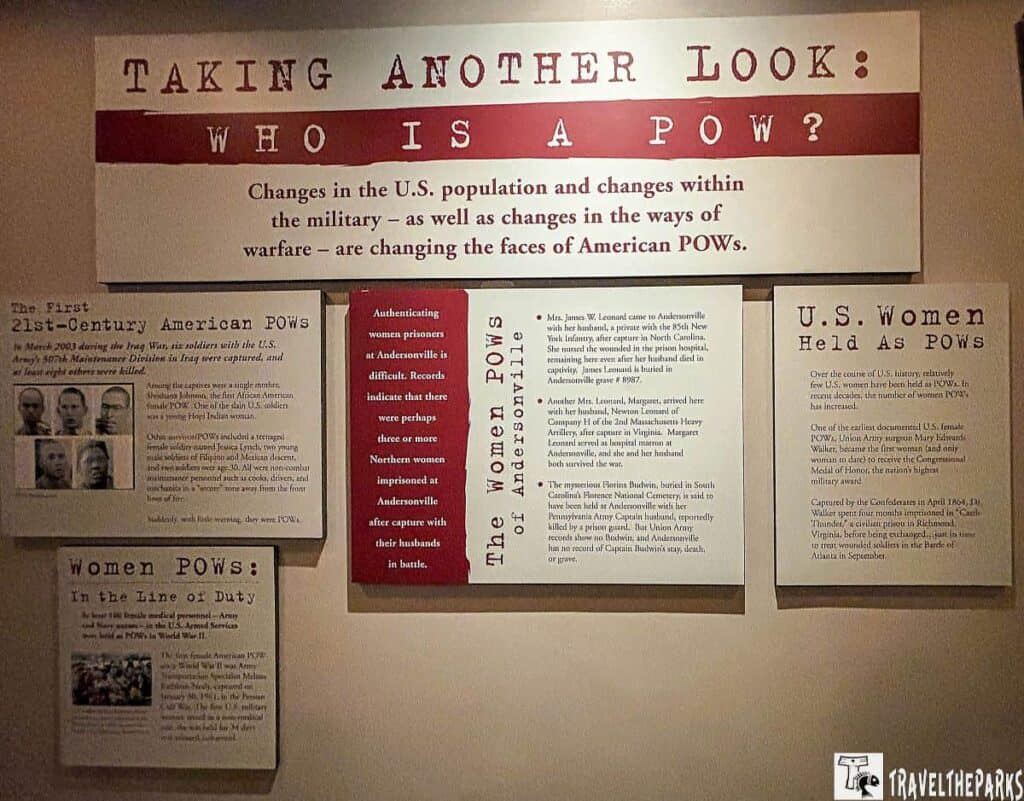
The museum’s educational focus gave it a more serious tone. The museum exhibits detail the capture, transport and liberation through the prisoner of war experiences. They showcase the problems of food rations, medical care, and overcrowding. Be sure to watch the short films shown in the theater. The first short film, “Voices from Andersonville,” offers a moving glimpse into the lives of the incarcerated, specifically those held at Andersonville. The second film, “Echoes of Captivity,” covers the history of POWs from the Revolution War through to the Gulf War, including moving accounts from former POWs.
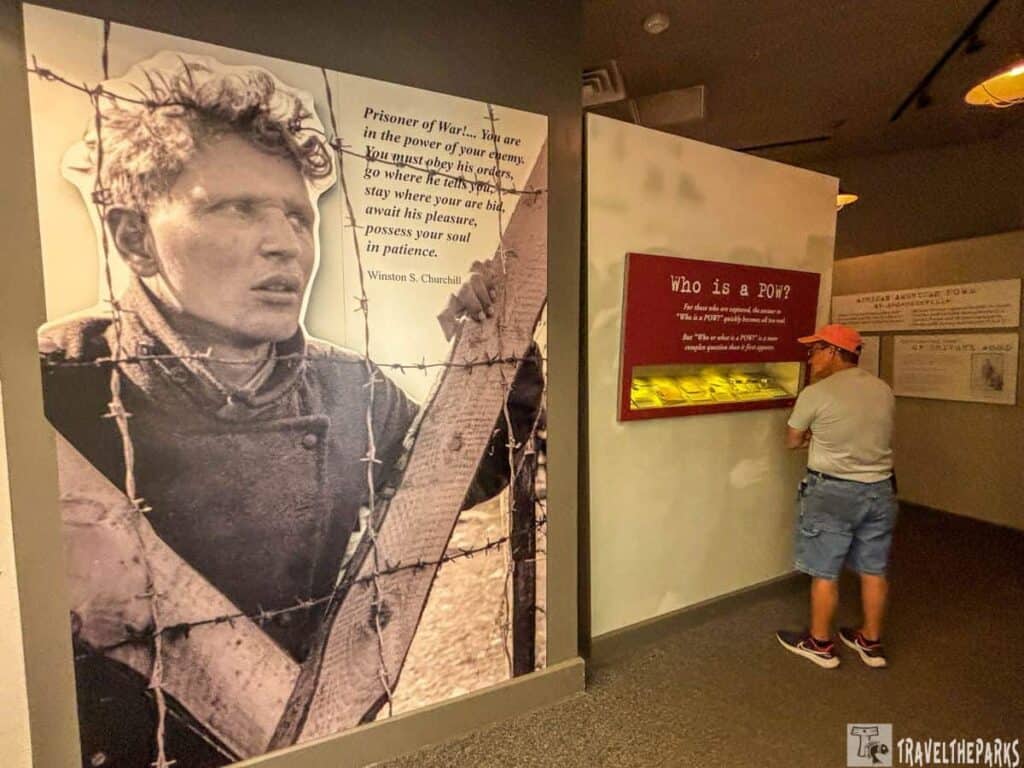
Captain Henry Wirz: Commandant of the Andersonville Civil War Prison
Captain Henry Wirz was a Swiss-born officer in the Confederate Army who gained notoriety for running the infamous Andersonville Prison. Under his watch, from 1864 to 1865, this facility became a terrible sight of suffering and death for the Union soldiers confined here. The 5-acre camp, designed to accommodate 10,000 prisoners of war, became incredibly overcrowded. Swelling at one point to a population of at least 32,000 desperate, emaciated men huddled together in what little shelter they had from a blisteringly hot Georgia sun. Diseases like dysentery, scurvy, and gangrene ran amok through the prisoner populations, taking even more lives of already weakened bodies. Over 13,000 of its soldiers suffered unimaginable horrors and died, their frail bodies cast into mass, unmarked graves. Its horrible conditions outraged the nation.
After the Confederacy fell, a military court arrested, tried, and convicted the notorious Wirz of conspiring to “impair the health and destroy the lives of Federal prisoners” and of “murder in violation of the laws of war.” on November 10, 1865, while protesting his innocence.
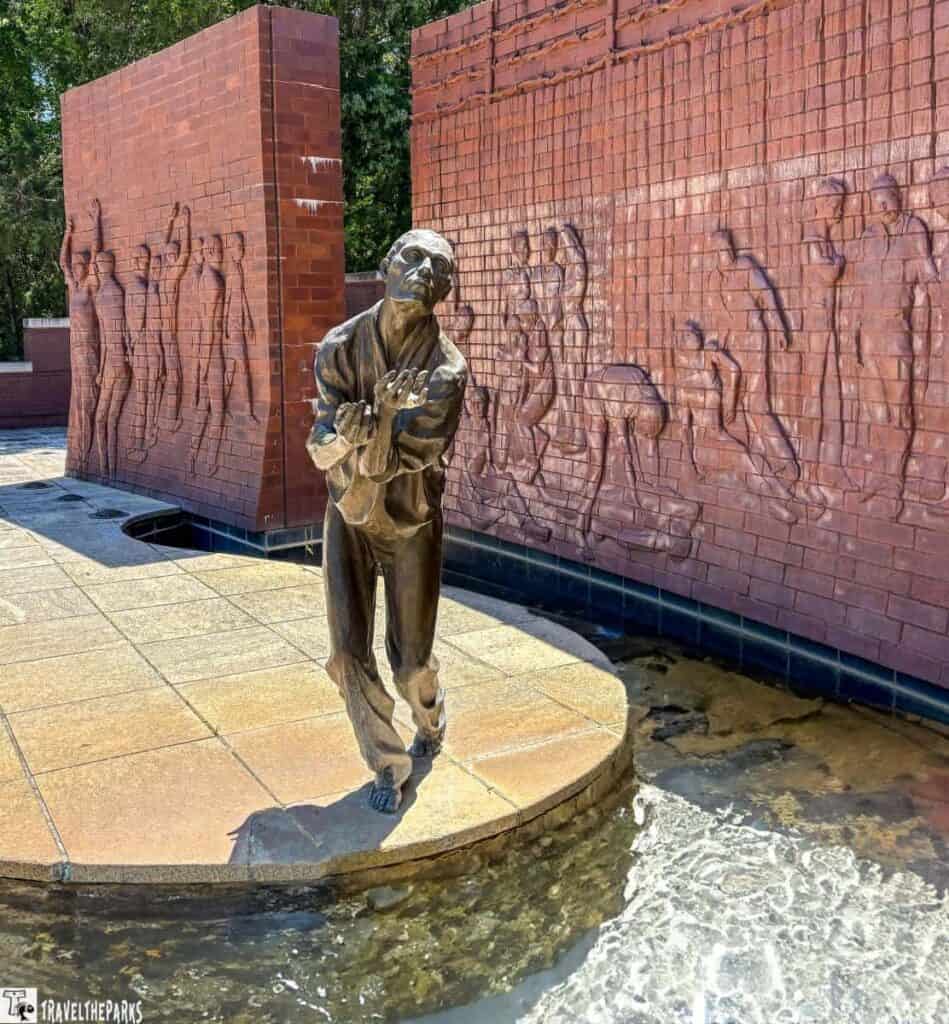
Explore the “Price of Freedom Paid” Courtyard: A Tribute to Sacrifice and Service
The thick, muggy air in Georgia feels even heavier outside the museum’s back doors. In front of us is the “Price of Freedom Paid” memorial, which honors the lives that were lost. In the center of the courtyard, a noticeable feature is a bronze statue of a Union soldier-water spills from his hands into the fountain. This number serves as a serious reminder of the substantial loss of life during the Civil War. The soldier stands firmly, representing all those who fought and lost their lives in the war, especially at Andersonville, where the conditions were harsh. The statue is serious, showing the pain of the soldier and the high cost of freedom for both the soldiers and the entire country.
The courtyard has memorial plaques that display the names of people who lost their lives and the statues show the personal sacrifices made during the war. These statues and memorials show the great pain experienced by the prisoners, many of whom died from illness, lack of food and overcrowding in the Confederate prison.
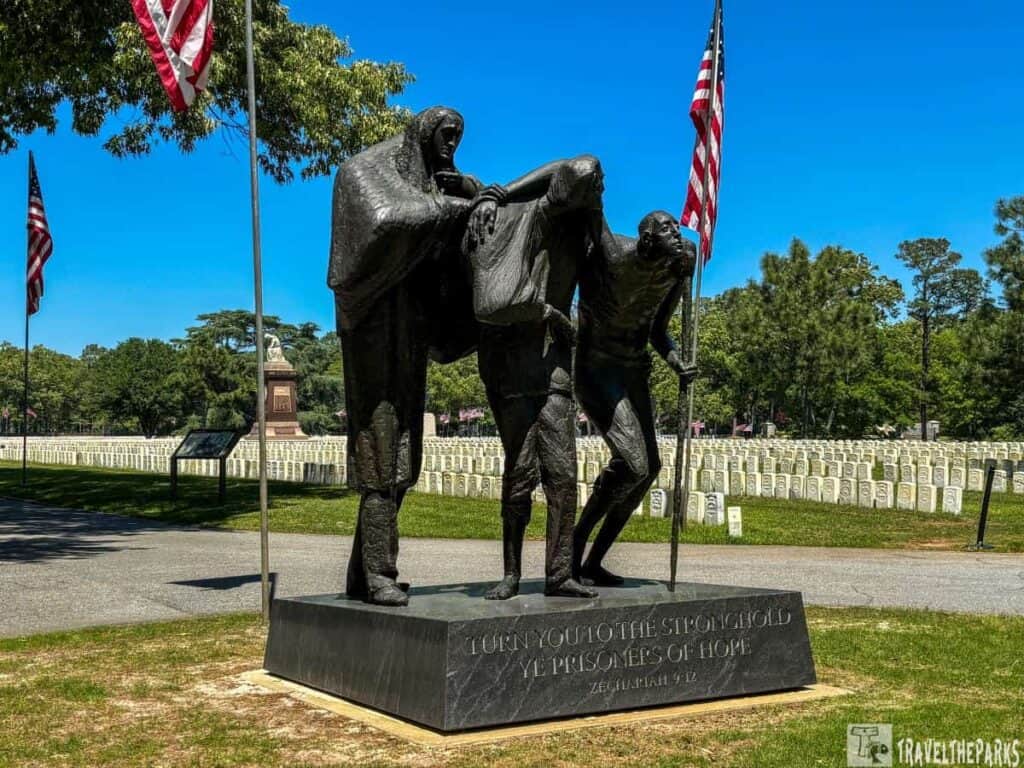
The Andersonville National Cemetery: Honor the Dead
Next, we headed to the Andersonville National Cemetery. It’s a spot for peaceful thinking and respect. This cemetery is the burial site for over 20,000 Union soldiers who lost their lives as prisoners of war at Andersonville. The long lines of white headstones serve as a touching reminder of the lives that were lost in the Civil War. Walk slowly through the cemetery, look at the names on the stones and honor the soldiers who have died. Walk through a field of over 13,000 white headstones. This includes those of prisoners of war and veterans from more recent conflicts. The tall Pennsylvania Memorial and the lists of those who died provide a moment for quiet thought.
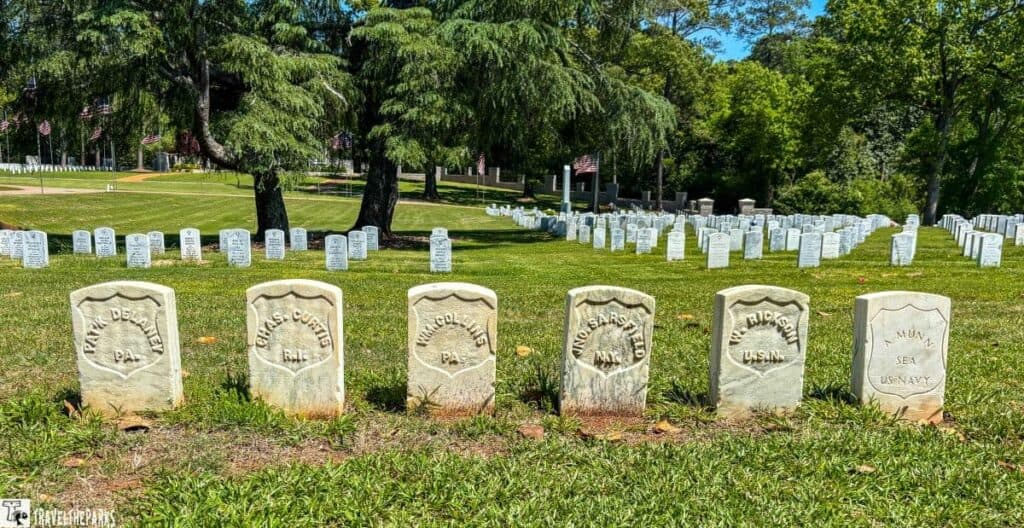
During our walk, we saw six isolated graves buried in a secluded corner of the cemetery. These burials remain linked to the Raiders’ Graves. Members of the Raiders, a ruthless gang who committed serious crimes inside the prison against other prisoners. In response, prisoners formed the Regulators—a militia backed by authorities to ferret out the raiders and dish out justice. They faced trial, a makeshift court-martial for robbery and murder. On July 11, 1864, the Regulators hanged six leaders of the gang in the stockade. Their actions marked a dark chapter in prison history-a visceral symbol of shame in a place already steeped in suffering.
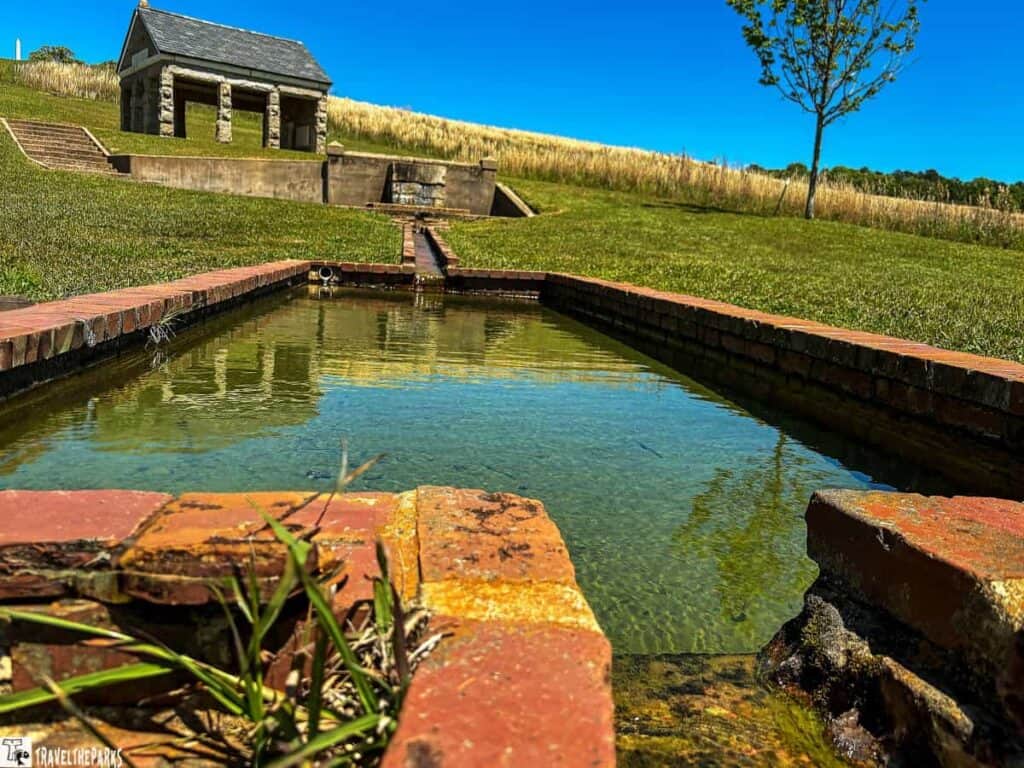
What to See on Your Self-Guided Audio Tour of Andersonville National Historic Site Civil War Prison
The focus of this site is the Andersonville Prison location itself. Fort Sumter Camp was a well-known Confederate prison camp that operated during the Civil War. You can take a ranger-guided or self-guided audio driving tour to see the area where many Union soldiers suffered brutal conditions. Camp Sumter housed 45,000 Union soldiers starting in 1864. It’s difficult to picture that many people on just 26 acres. Only a fraction of the original camp still exists today. Exploring the area of Camp Sumter, we saw the rebuilt stockade walls, memorials and Providence Spring, which provided much-needed water during the prison’s toughest times.
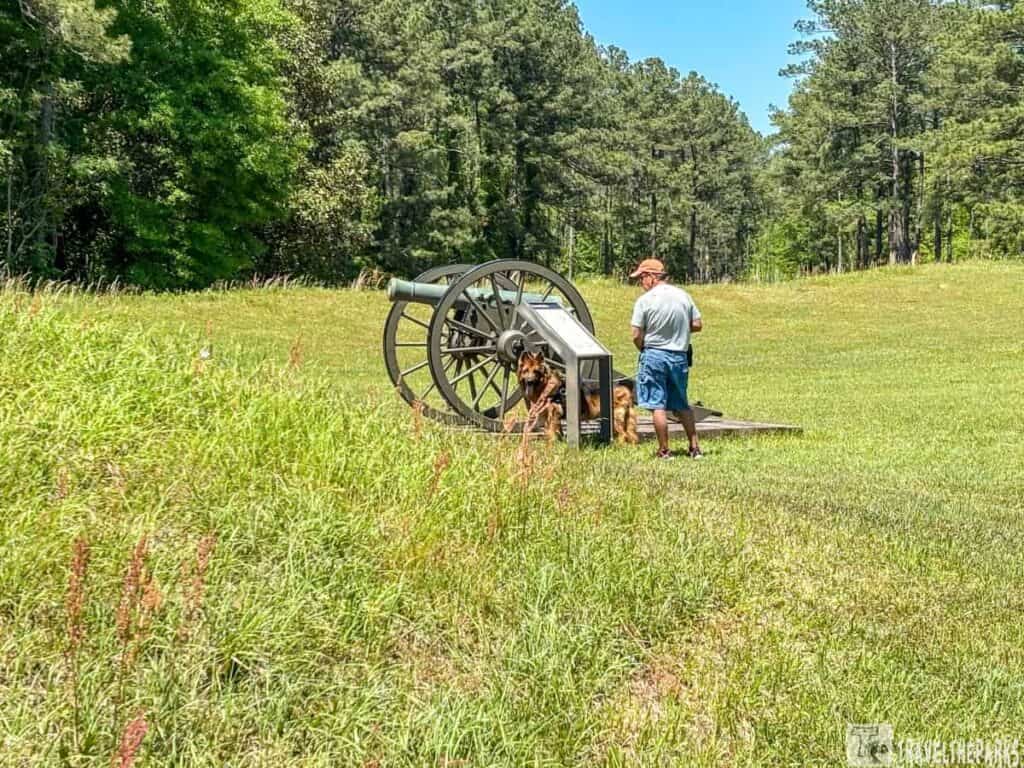
Exploring the Earthworks and Guard Posts
Just outside the visitor center/museum are the earthworks. Walking these, we could see a series of trenches and protective walls built to strengthen the area around the stockade. This made sure the prisoners stayed put, and couldn’t leave. At the edge of the camp, soldiers set up guard posts and artillery stations to watch the prisoners closely. They enforced strict rules, including the “dead line, ” which was a dangerous boundary that prisoners were not allowed to cross or they would face serious consequences.
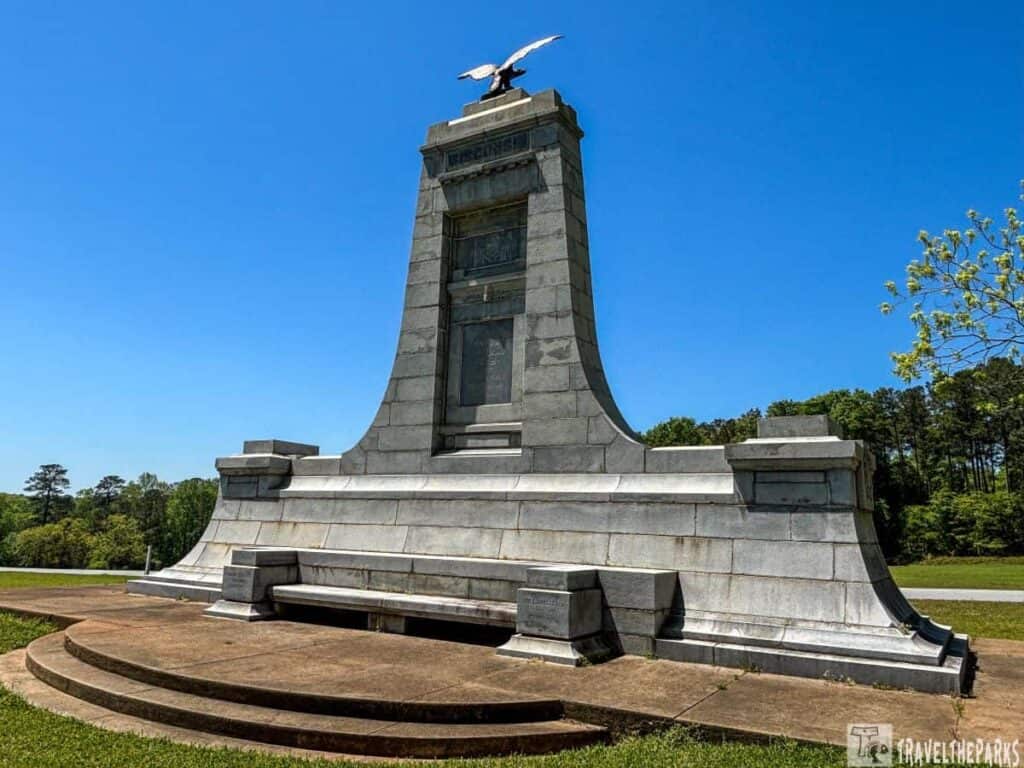
Stop 1: The Wisconsin Monument
The Wisconsin Monument, dedicated in 1907, is one of the earliest and most prominent state memorials at Andersonville. The monument commemorates almost 1,200 Wisconsin soldiers who died at Andersonville during the Civil War because of harsh conditions. We wandered a few of the other monuments. The Massachusetts Monument honors specific state regiments. The Clara Barton Monument commemorates her role in identifying the dead.

One of the most notable monuments was of Father Peter Whelan. A Catholic priest from Savannah, Georgia, he is remembered as one of the few figures who provided compassionate care to the Union prisoners at Andersonville Prison during the Civil War. Known too many as the “Angel of Andersonville,” Father Whelan voluntarily ministered to the sick and dying men held in Camp Sumter, despite the overcrowded, unsanitary, and disease-ridden conditions.
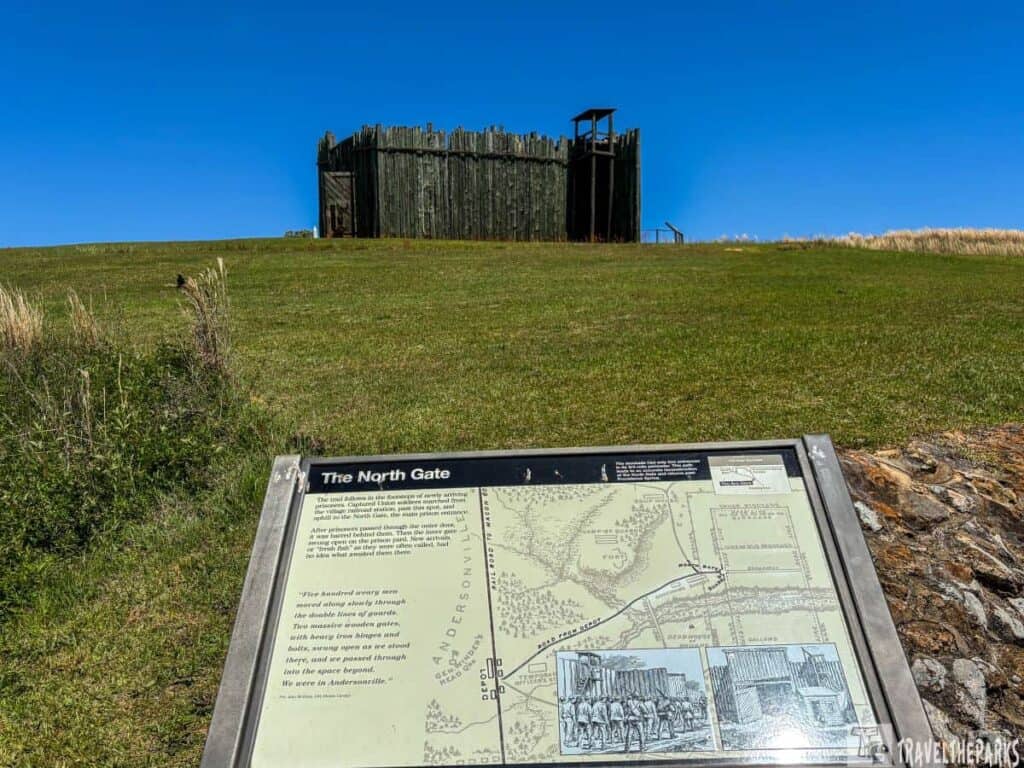
Stop 2: North Gate Andersonville Prison Camp
The North Gate marks one of the original entrances to Camp Sumter (Andersonville Prison), where Confederate forces brought in Union soldiers and forced them to endure the appalling conditions of the Confederate prison.
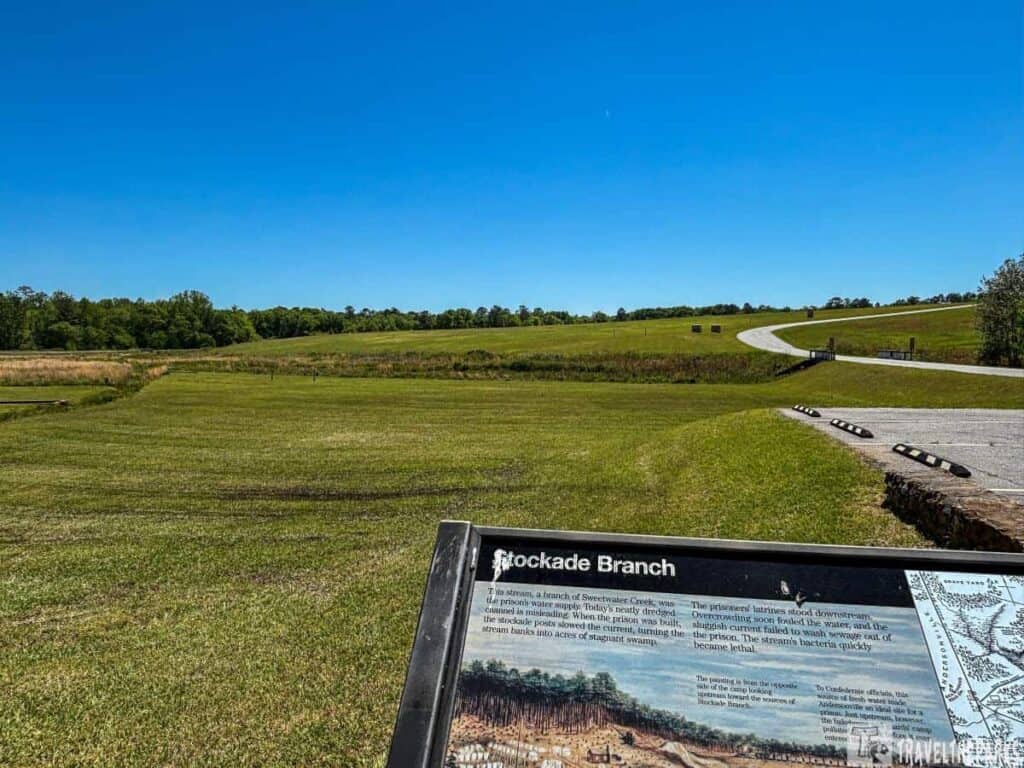
Stockade Branch, a small stream, runs below the north gate was in an area called the Sinks. Unfortunately, because of the overcrowded conditions and lack of proper sanitation, the stream quickly became contaminated, adding to the dire conditions at the prison. Imagine 45,000 prisoners bathing, doing laundry and drinking from such a trickle of water filled with human waste.
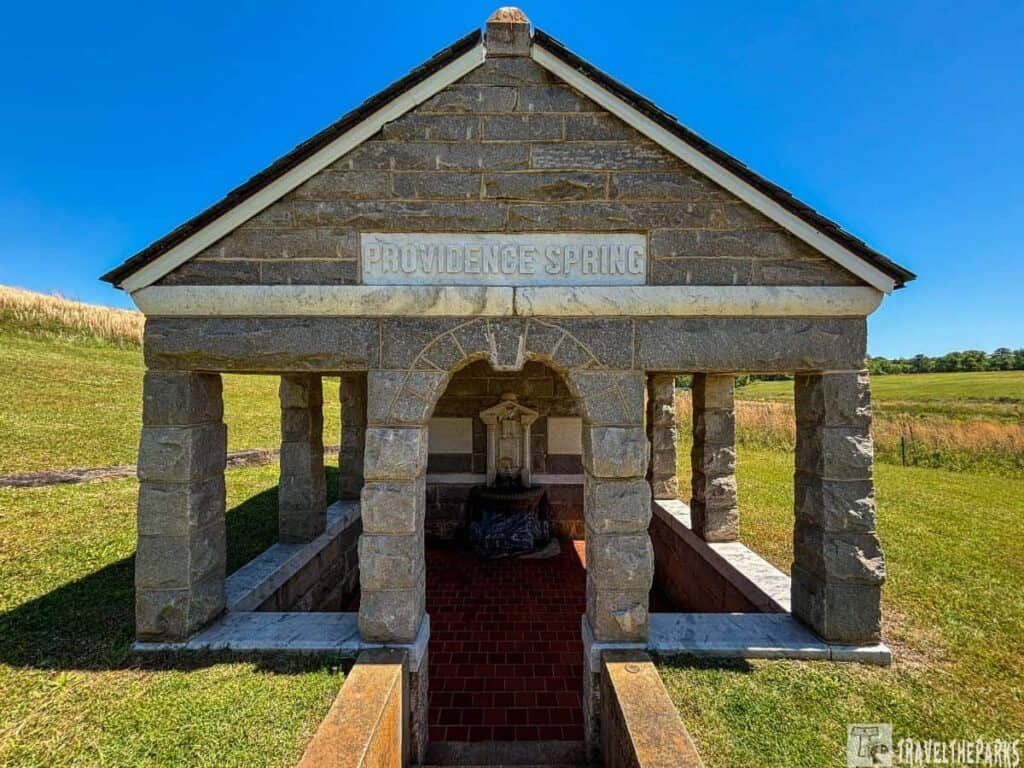
Stop 3: Providence Spring
Providence Spring stands as a powerful symbol of hope and survival. This spring miraculously appeared in August 1864 after a lightning storm during a dire water shortage. Many prisoners believed it was an act of divine intervention. It was a small but significant source of life in an otherwise bleak and deadly environment.
Today, a monument marks Providence Spring’s historical importance, reminding visitors of the extraordinary challenges and resilience of those who endured Andersonville Prison. Many of whom succumbed to disease because of unsanitary conditions, including the contamination of water sources.
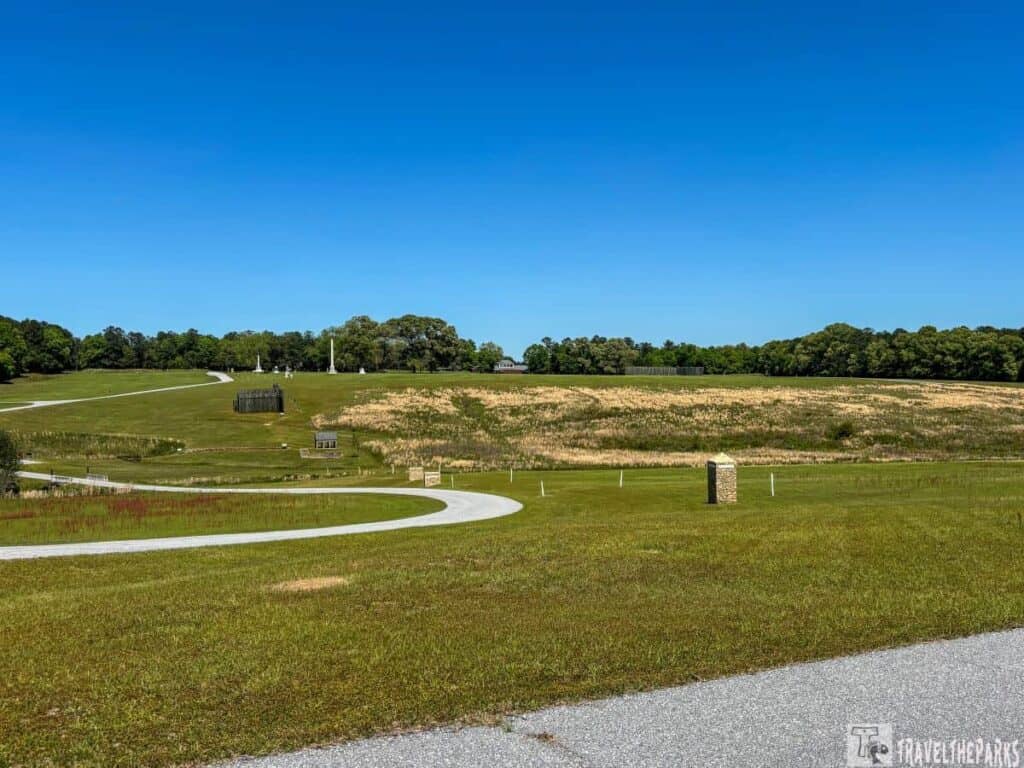
Stop 4: The Bakehouse, South Gate, and Dead House at Andersonville National Historic Site
As we continued our self-guided tour of Andersonville National Historic Site, stop at the Bakehouse, South Gate, and Dead House. Of course, the Bakehouse faced overwhelming demand because of the overcrowding of the camp and the limited supplies available.
Prisoners and supplies entered through the South Gate, which marked the point where men faced the horrific conditions of Camp Sumter.The South Gate was another key entrance into the prison. It was used for the arrival of prisoners and supplies, marking the point where men were forcibly brought into the horrific conditions of Camp Sumter.
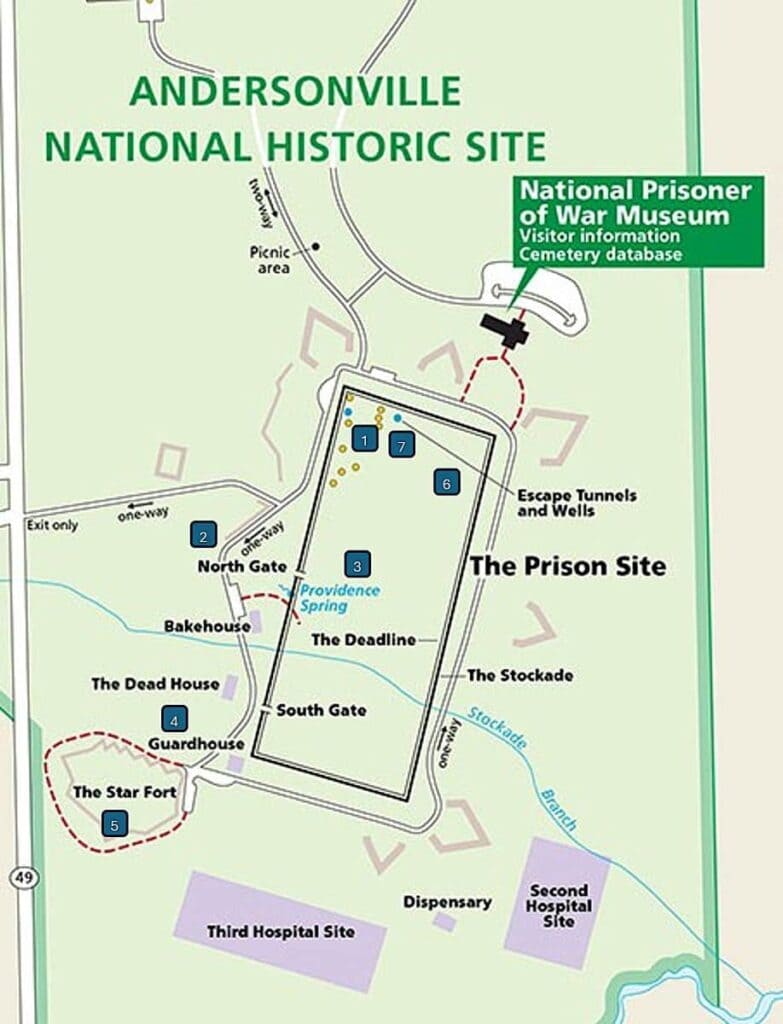
Close to the South Gate, the Dead House was where the bodies of the deceased prisoners were stored before being buried. During the peak of the prison’s overcrowding, this small, dark building became a grim holding area for the dead. With nearly 13,000 Union soldiers dying at Andersonville from disease, malnutrition, and overcrowding, the Dead House serves as a somber reminder of the high mortality rate at the camp and the suffering endured by so many.
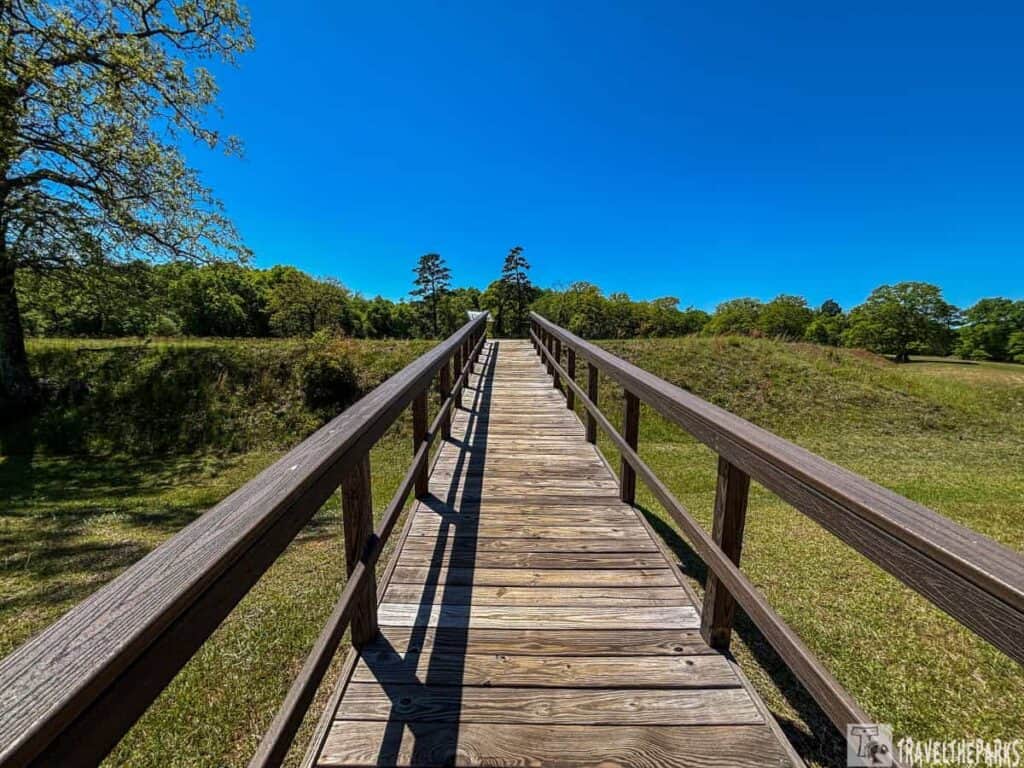
Stop 4: Star Fort the Primary Earthwork at Andersonville NHS
A short walk from the parking area, this well-preserved Confederate earthwork fort housed cannons to suppress uprisings and deter Union raids. This earthen fort was built in a star-shaped configuration for maximum visibility and firing angles. The fort sat on high ground, offering a commanding view of the prison and the surrounding countryside. Occupied by Confederate troops, the Star Fort served both as a deterrent against escape and a defense against potential Union raids.
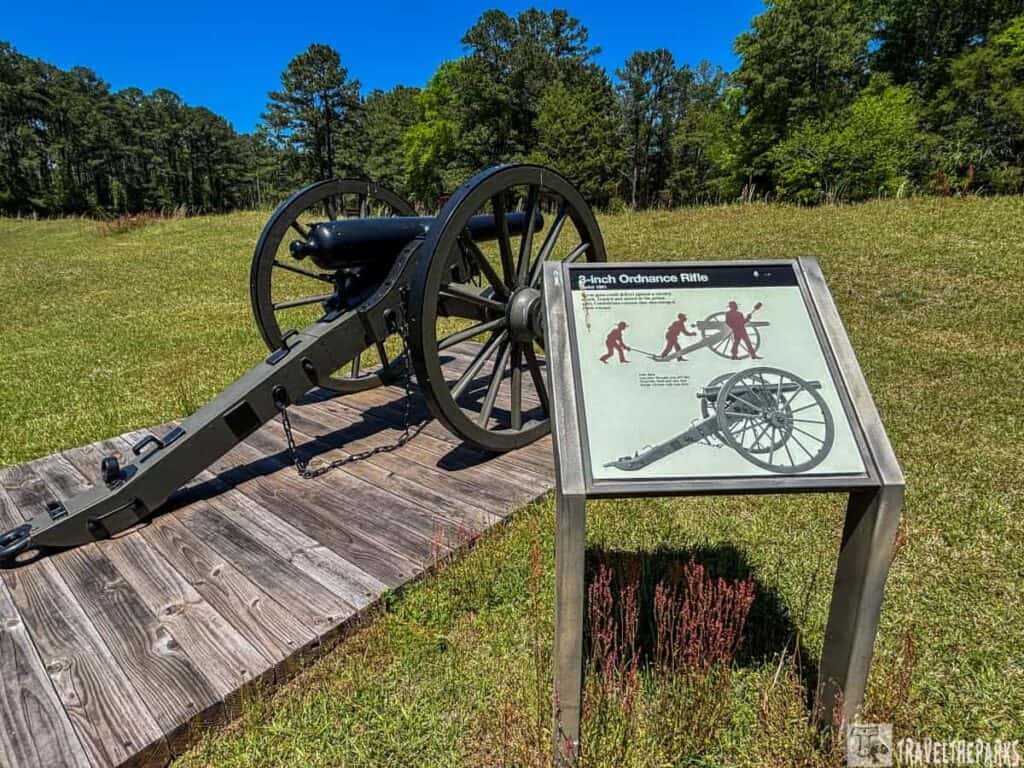
They fortified the Star Fort with nine 3-inch Ordnance Rifles. These cannons could hit targets effectively at a distance of about half a mile. Soldiers placed these cannons in key locations to protect against outside dangers and internal problems. Four of the guns were pointed outward, prepared to defend against any attacks from Union cavalry. More threateningly, they aimed the other five cannons at the prison itself. This gave the thousands of Union prisoners inside a clear warning: any rebellion or escape attempt would meet with serious consequences.
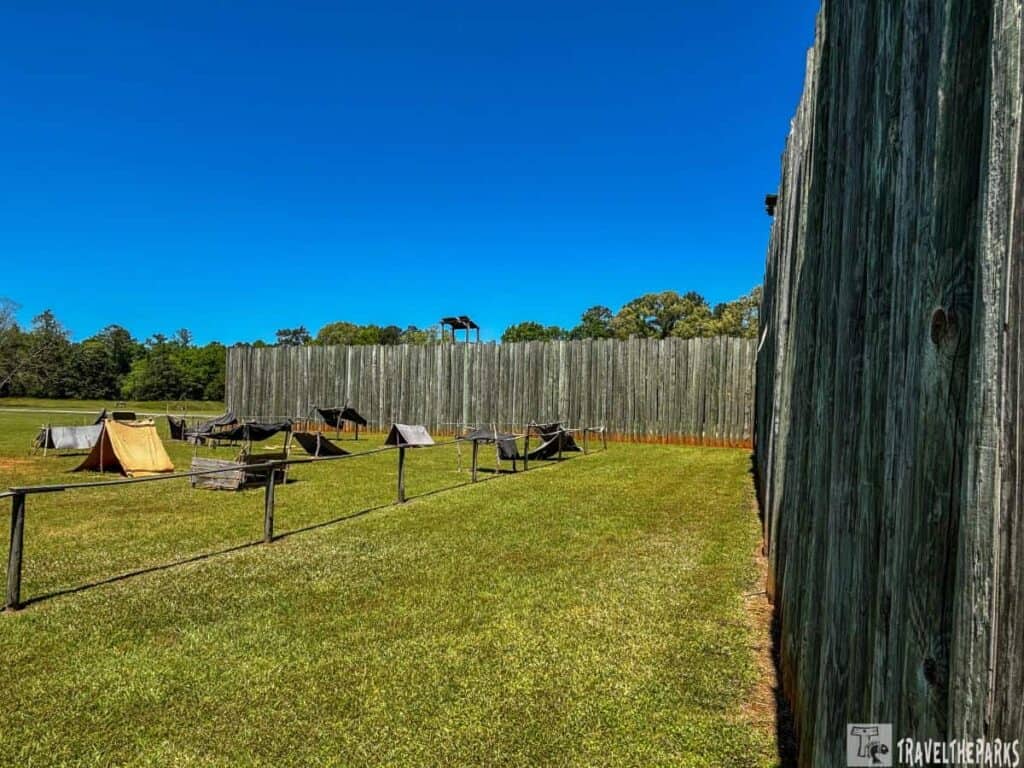
Stop 6: Stockade Reconstruction
The Stockade Reconstruction gave us a strong visual picture of what the original walls of Camp Sumter prison looked like during the Civil War. The wooden fence made from pine logs used to surround most of the 26 acres holding all the Union prisoners during its busiest time—over three times more than it was meant to hold.
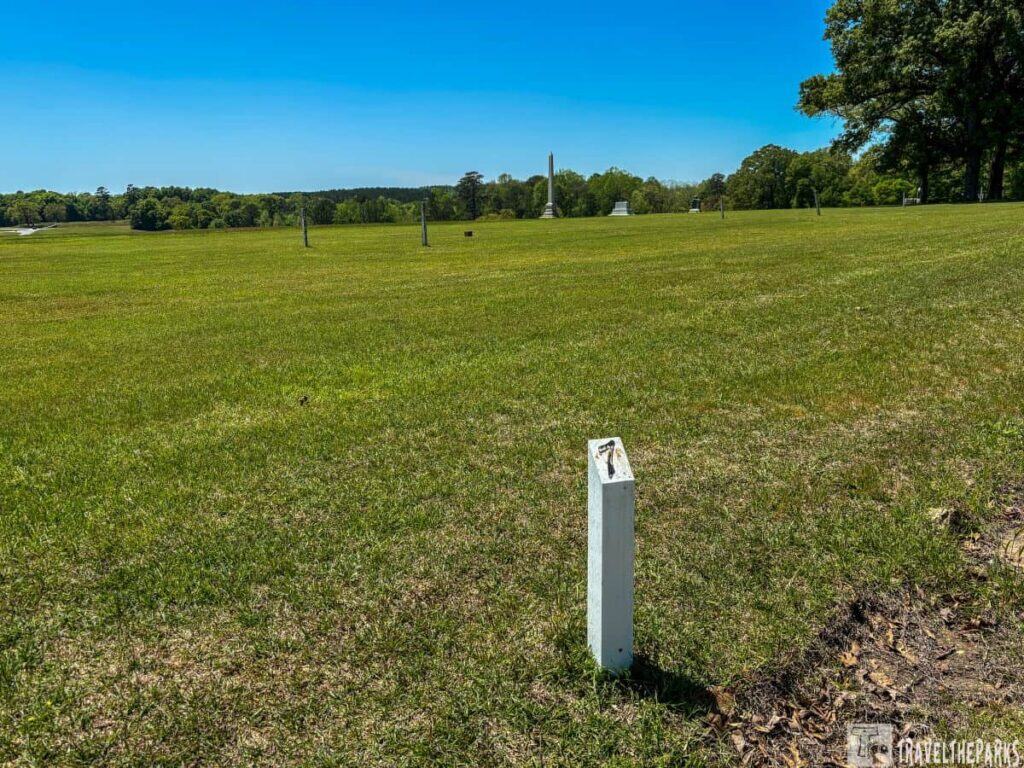
This reconstructed section of the wall, complete with a guard tower and the infamous “dead line” marked on the ground, helps bring history to life. The white post marked the dead line; a boundary about 19 feet inside the stockade wall that prisoners were forbidden to cross. Anyone who stepped beyond it risked being shot on sight by guards stationed above. For me, it was a chilling reminder of how strictly—and lethally—the camp was controlled.

The Shebang Area displays show how prisoners sheltered from the weather. We could view the reconstructed examples of “shebangs”, makeshift shelters built by prisoners. Interpretive kiosk panels give us a clear picture of daily life at the camp. I saw the lack of proper housing, but I was impressed by how the men used scraps and ingenuity to survive. The camp’s purpose was the secure confinement and control of large numbers of prisoners.
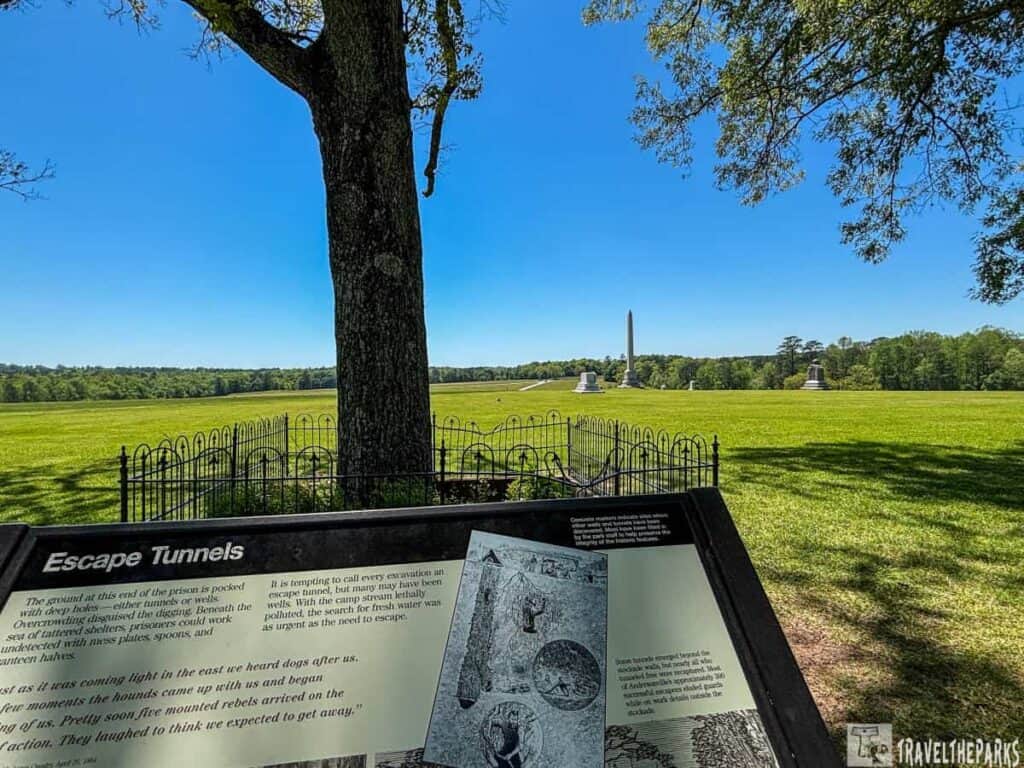
Stop 7: Wells or Escape Tunnels
At this stop, we explored one of the most resourceful—yet hopeful—aspects of prisoner life at Camp Sumter: the wells dug for water and the tunnels dug for escape.
Desperate for clean water, Union prisoners often dug shallow wells by hand inside the stockade. These makeshift wells were essential for survival, especially before the appearance of Providence Spring in August 1864. Though most provided limited relief, they demonstrate the prisoners’ resilience and ingenuity under extreme conditions.
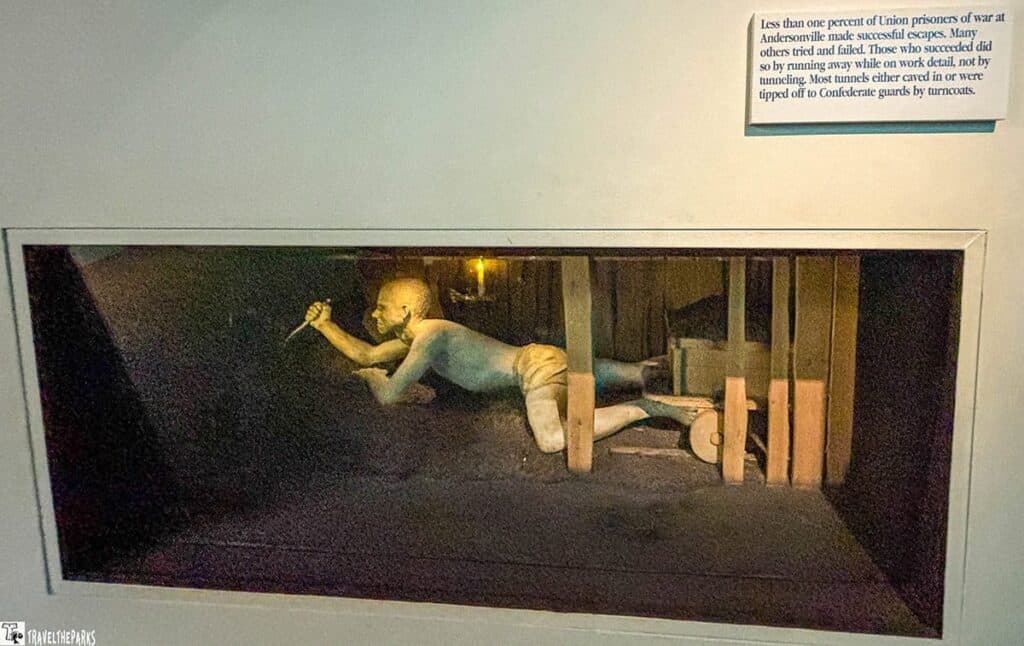
In secret, some prisoners used these same wells as a cover for tunnel escapes, digging sideways from the bottom to try to reach beyond the stockade walls. These escape tunnels were narrow, dark, and dangerous—constructed with stolen tools, scraps of wood, or even bare hands. Most were discovered before escape attempts could succeed, but a few brave men made it out, only to face recapture or the wilderness beyond.
When you visit this site, it’s difficult not to feel a strong respect for the people who went through so much suffering here. I highly recommend the audio tour, as it makes the drive more poignant with stories directly related to prisoners. It was very moving, and for us, Andersonville was a real eye-opener.
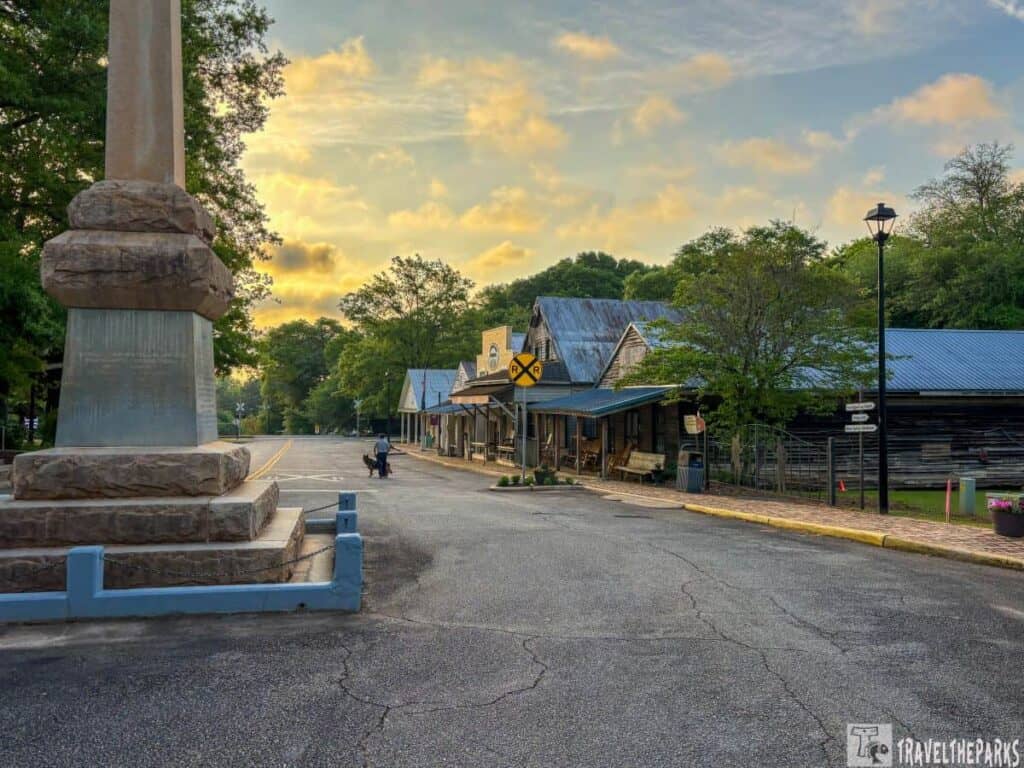
Top Things to Do in the Town of Andersonville
Once we completed our tour of the National Historic Site, we decided to check out the town of Andersonville. This small but lovely town has many old buildings that highlight its interesting past from the Civil War period. As we walked around the town, we noticed many old homes, churches and buildings that show its history from the 19th century. The walking tour is self-led, and there are signs that give historical information.
- Drummer Boy Civil War Museum features a unique collection that honors the contributions of soldiers in the Civil War. It showcases civil war uniforms, dioramas, and stories that highlight their roles in battles. It is open daily 9 AM to 5PM. Admission: adults-$5, Age 13-17-$1, under 13-free.
- Pioneer Farm: Beyond the haunting Andersonville Civil War history is the quiet counterpoint of the Andersonville Pioneer Farm. This living history site re-creates 19th-century rural Georgia, where weathered cabins, split-rail fences, and heirloom crops tell a story of survival far removed from the camp’s horrors. This 6-acre farm includes an old jailhouse, possum trot postal service, cane works-syrup kettle, original log cabin, gristmill, blacksmith shop and a few other restored buildings.
- Andersonville Railroad Depot: It was first built as a train station and was important for transporting prisoners to the well-known Andersonville prison. Today, the depot features a small museum that shows visitors the town’s railroad history.
- Henry Wirz Monument: Stands as one of the most contentious memorials in the U.S. Dedicated in 1909 by the United Daughters of the Confederacy. It honors Confederate Captain Heinrich “Henry” Wirz, the only officer executed for war crimes after the Civil War.
- St. James Pennington Log Church: Built in the 1800s, it showcases classic log cabin architecture. The church served early settlers and reflected their strong faith and community spirit.
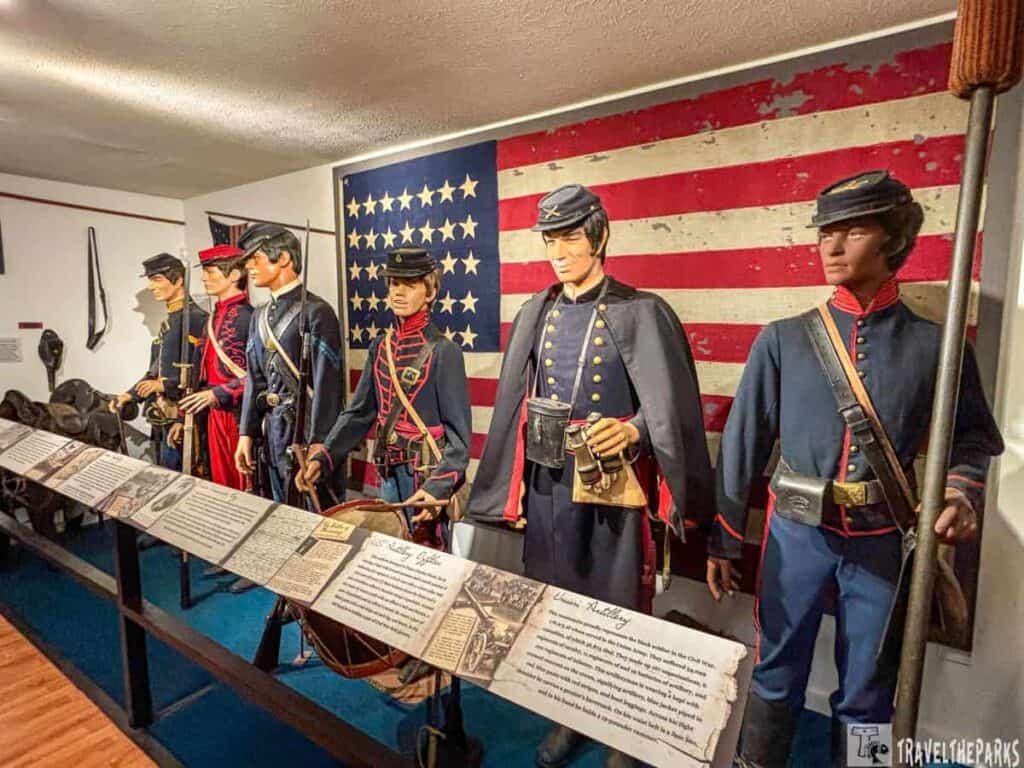
How to Find the Best Places to Dine in the Neighborhood
- Local Cafes and Shops: After a day of reflection, you can unwind in the town’s small cafes and local shops. The community is friendly, and there’s a lot of local charm to soak in. Both Sweet Tee’s and Dee’s Dirty Dogs, LLC. are available on Thursdays Easterlins Bandstand (114 Church St) in town.
- Since the area is rural, most restaurants are in nearby towns like Americus (10–15 minutes away) and Plains (15–20 minutes away)
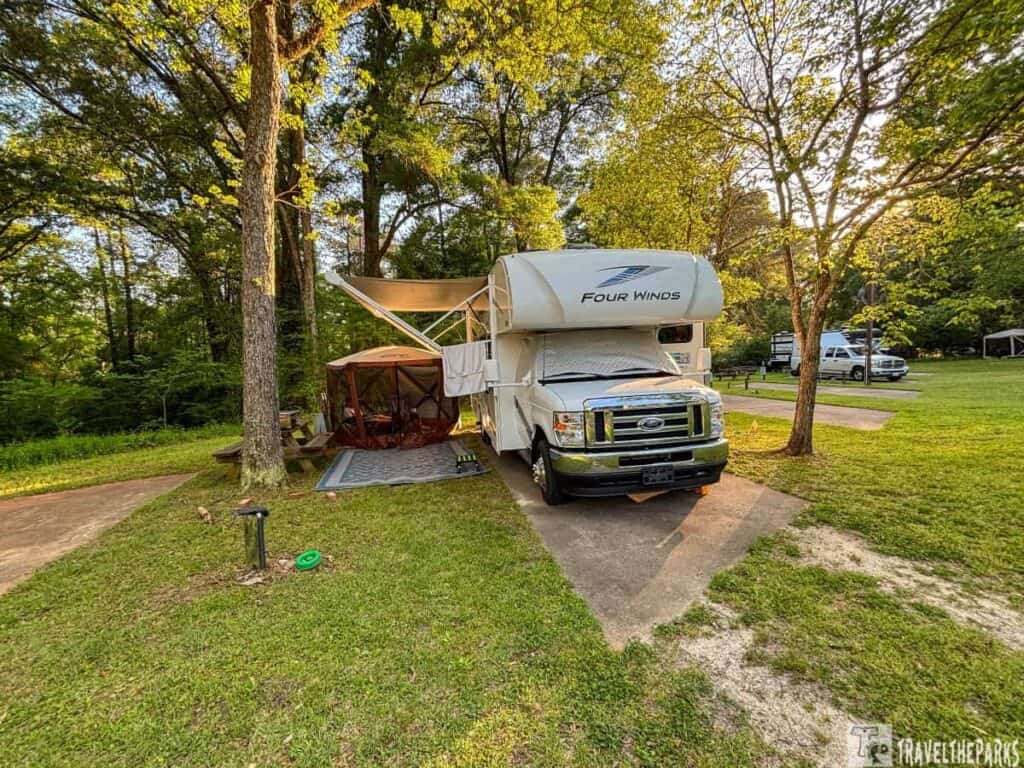
Unwind at the Andersonville RV Campground to End Your Day
After our long day of learning about history, thinking things over and discovering new places, we returned to the Andersonville RV Campground. After a busy day, the park provides a calm place to think about what you’ve learned. The peaceful surroundings, along with the sounds of nature, create an ideal spot to relax.
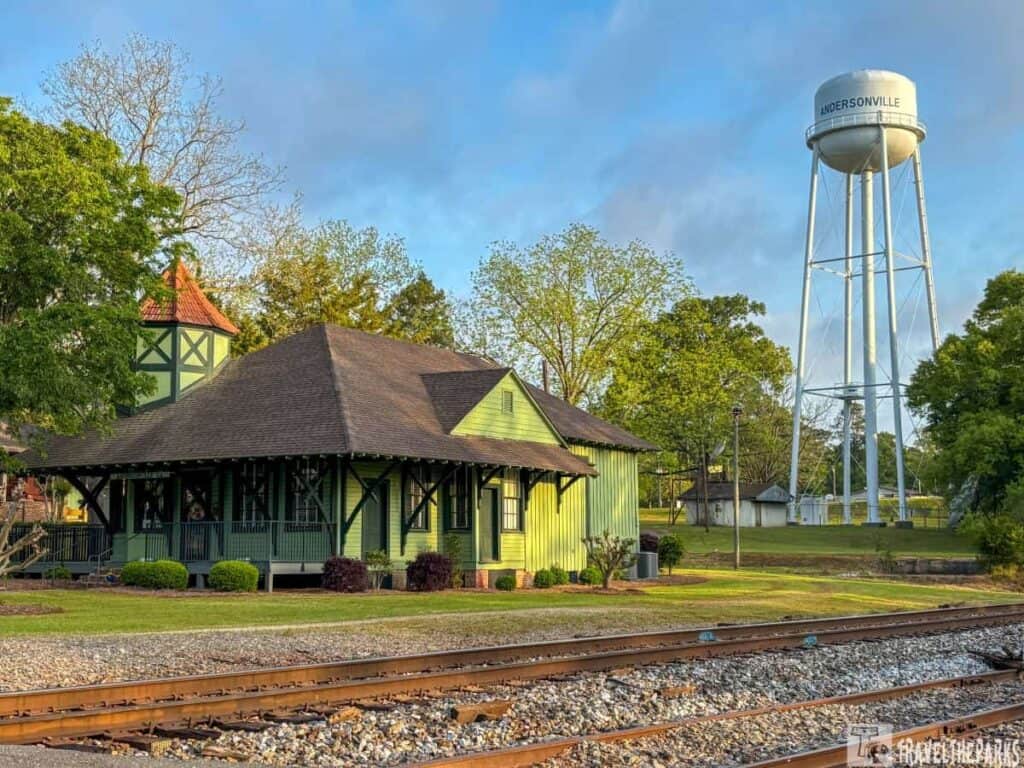
Final Thoughts: How to Make the Most of Your Visit to Andersonville National Historic Site
Fort Pulaski and Andersonville are both significant Civil War sites in Georgia, but they represent very different aspects of the conflict. Both sites underscore the Civil War’s multifaceted impact—Fort Pulaski through military innovation and Andersonville through its tragic human toll. While one reflects advancements in warfare, the other exposes the conflict’s darkest humanitarian failures. Visiting both as part of a Georgia road trip offers a deeper, more balanced understanding of the state’s pivotal role in the nation’s most defining conflict.
The Andersonville National Historic Site is a place you should definitely visit on your next road trip. It provides a powerful experience for anyone wanting to connect with America’s history. For me, the simplicity of the pioneer farm underscores a jarring contrast: while soldiers starved in overcrowded barracks, civilians nearby wrestled with their own battle against the land. It’s a reminder that war’s reach stretches far beyond battlefields, etching hardship into every corner of life.
Pin this guide, share it with fellow travelers, or save it for your next road trip through Georgia. History awaits! Plan your pilgrimage to Andersonville National Historic Site, where history lives, and heroes are never forgotten.

